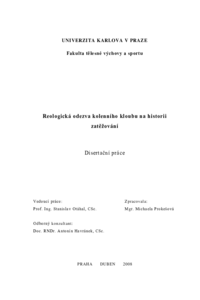Reologická odezva kolenního kloubu na historii zatěžování
The rheological response to a history of knee joint loading
dissertation thesis (DEFENDED)

View/
Permanent link
http://hdl.handle.net/20.500.11956/124916Identifiers
Study Information System: 135176
CU Caralogue: 990010030540106986
Collections
- Kvalifikační práce [9041]
Author
Advisor
Referee
Jelen, Karel
Vilímek, Miloslav
Faculty / Institute
Faculty of Physical Education and Sport
Discipline
-
Department
Information is unavailable
Date of defense
18. 9. 2008
Publisher
Univerzita Karlova, Fakulta tělesné výchovy a sportuLanguage
Czech
Grade
Pass
Souhrn Název práce: Reologická odezva kolenního kloubu na historii zatěžování Cíl práce: Prověřit možnosti reologické interpretace pasivních odporů v kolenním kloubu při jednoduchém vynuceném pohybu kolena v rovině sagitální do flexe a extenze. Metoda: Pomocí bioreometrického měření rozlišit vliv zátěžové historie na reologické vlastnosti kolenního kloubu. Vlastní metoda je založena na experimentálním in vivo měření pasivního momentu (odporu) kolena, jakožto specifické, reologické odezvy kolenního kloubu na vynucený pohyb kolena do flexe a extenze. Výsledná naměřená závislost pasivního momentu M na úhlu ohybu kolena φ je tedy sumární reologickou charakteristikou pasivních silových vlastností celého kloubu a jeho okolí. Grafické znázornění hysterezního průběhu momentu síly nazýváme bioreogam. Výsledky: Výsledky ukázaly, že specifická odezva kolenního kloubu na různou historii zatěžování se projevuje změnou reologických vlastností daného kolena. Např. bylo zjištěno, že ohybová viskozita ηM a ztrátová energie EZ stoupaly s věkem. Závěr: Podařilo se zkonstruovat měřící zařízení pojmenované bioreometr (včetně vypracování metodiky měření), pomocí něhož lze komplexně měřit reologické vlastnosti kolenního kloubu in vivo. Klíčová slova: bioreogram, bioreometr, kolenní kloub, pasivní odpor, reologická odezva,...
Title: The rheological response to a history of knee joint loading Aim: The purpose of this work is to illustrate the possibilities of rheological interpretation of passive resistance in the knee joint during simple forced movement of the knee flexion and extension in the sagittal plane. Methods: With the help of biorheometrical measurements, we identify the effect that a weight bearing history has on the actual rheological properties of the knee joint. The methods are based on an experiment carried out in vivo, passive momentum (resistance) of the knee joint during forced flexion and extension are measured and expressed as the specific rheological response of the knee joint. The dependence of passive momentum M on the angle of flexion φ is hereby characterized as the total rheological characteristic of passive forces on the whole knee and its surroundings. The graphical interpretation of the duration of the momentum force is named - biorheogram. Result: Results of experimental study presented in this dissertation distinctly shows that rheologic interpretation of passive resistance in the knee joint during simple forced movement of the knee joint in the sagittal plane is possible in flexion and extension. Conclusion: Rheologic description of hysteretic response of passive resistance {moment of...
